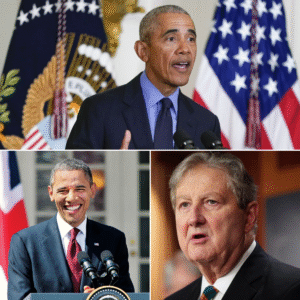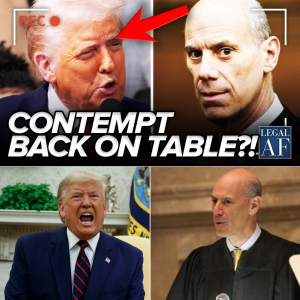A dramatic and completely unverified political storyline swept across social media this week after a viral post claimed that Senator John Neely Kennedy confronted former President Barack Obama with a “$638 million ghost money exposé.” The fabricated narrative, featuring a theatrical binder labeled “OBAMA FOUNDATION – THE VANISHING ACT,” ignited millions of comments, shares, and reactions despite having no basis in reality, according to public records and financial disclosures.
While the story is fictional, its explosive spread highlights the growing influence of AI-generated narratives, politically charged misinformation, and public appetite for sensational political theater.

The Birth of the Viral Story
The narrative emerged on multiple social platforms in a highly stylized, emotionally charged format. According to the viral version, Senator Kennedy allegedly walked into a hearing holding a thick black binder and confronted Obama about “vanishing” funds connected to the Obama Foundation. The fictional script describes Obama having a meltdown, shouting, “This is my legacy you’re touching!”
None of these events occurred.
There were no hearings, no binders, no confrontations, and no statements from either Kennedy or Obama matching the viral claims. But the dramatic framing pushed the post into rapid circulation, amplified by provocative hashtags such as #fblifestyle and #JohnNeelyKennedy.
Why the Hoax Spread So Quickly
Analysts who study digital misinformation note that several factors fueled the virality of this fabricated exposé:
1. Familiar Character Archetypes
Senator Kennedy’s reputation for witty, blunt remarks in congressional hearings—and Obama’s global prominence—made the fictional confrontation feel emotionally plausible to some readers, even if factually impossible.
2. The “Black Binder” Trope
Political fiction often uses physical props to create a sense of evidence and urgency. The image of a phone-book-thick binder labeled “THE VANISHING ACT” taps into the public’s fascination with conspiratorial documentation.
3. AI-Enhanced Storytelling
Many posts included AI-generated images and mock screenshots designed to resemble real congressional rooms, giving the hoax additional perceived credibility.
4. Distrust and Polarization
In an era of intense political division, audiences often share stories that reinforce their preexisting beliefs—sometimes without verifying their authenticity.
Fact-Checking the Claims
A review of publicly available records and statements dismantles every component of the viral narrative:
-
No congressional hearing involving Kennedy and Obama took place.
-
Former presidents do not testify before Senate committees in such confrontational settings.
-
The Obama Foundation’s financial disclosures are public and show no missing $638 million.
-
No meltdown or confrontation was documented by any news outlet, verified journalist, or official spokesperson.
-
The “black binder” image circulating online is AI-generated, not a real object photographed in Congress.
Despite these clear contradictions, millions of people encountered the hoax before fact-checkers intervened.
The Psychology Behind Political Viral Fiction
Digital researchers say this story reflects a larger trend: political fan-fiction masquerading as news. These narratives blend fiction with real public figures, creating a hybrid genre that can be entertaining, misleading, or intentionally manipulative.
Three major psychological drivers are at play:
1. Desire for Dramatic Resolution
People gravitate toward stories where a hero exposes wrongdoing or a villain faces justice. These narratives offer emotional satisfaction, even when entirely fabricated.
2. Believability Through Specificity
The mention of a specific dollar amount — “$638 million” — lends an illusion of authenticity, even though it has no factual foundation.
3. Visual Credibility
AI imagery can simulate official documents, sealed evidence, or courtroom scenes that look convincing at first glance.
Real-World Impact: Why This Hoax Matters
While some users recognized the story as satire or political entertainment, others believed it to be true. Experts warn that viral fabrications like this can:
-
Damage trust in legitimate institutions
-
Spread false accusations against public figures
-
Influence voter perceptions
-
Distract from real policy issues and debates
-
Amplify polarized narratives that divide communities
As political misinformation grows more sophisticated, the line between fiction and fact becomes easier to blur — especially when powerful public figures are placed at the center of dramatic storytelling.
Conclusion: A Case Study in Modern Digital Myth-Making
The viral claim that Senator Kennedy “exposed” the Obama Foundation with a $638 million dossier is a textbook example of how quickly political fiction can be mistaken for fact in the digital age. Though the event never occurred, its emotional punch, dramatic characters, and quasi-realistic imagery helped it spread faster than many verified news stories.
As election cycles intensify and AI tools become more accessible, analysts expect similar hoaxes to become more common — making media literacy more crucial than ever.





